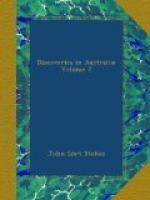No improvement had taken place in colonial affairs, and the sales of land, in consequence of the high price, were very limited. The fact was, the regulations that had recently been made gave very little satisfaction. By these the minimum price was fixed at one pound per acre; in consequence of which many predicted that millions of acres would be excluded from the market for ages to come, as it seemed not conceivable that any change could make them worth a quarter that sum, especially as on an average the natural grasses of the country will only support one sheep to four acres. The inevitable consequence was to prevent an augmentation of the emigration fund, which inflicted a serious evil on the colony, though by many the high price was considered a great boon, as it enabled them to enjoy, at a trifling charge, immense back runs, as safe from the intrusion of interlopers as if they had been granted by the Crown in perpetuity. It is my impression that the attempt to raise the largest sum of money by the sale of the smallest number of allotments is unwise, as it operates as a discouragement to small capitalists, who wish to occupy the land for themselves; it would in the end be more advantageous almost to give the land away, to a certain extent, in order to encourage people to go there. It may be worth remarking here, that on a rough calculation the pound per acre system would realise, supposing the whole continent were sold, the sum of about 1,679,616,000 pounds.
UNSETTLED BOUNDARIES.
The most curious circumstance connected with the division of land in New South Wales, is the uncertainty that prevails respecting the boundary line of estates, which must be the source of endless disputes and expensive litigation among the colonists. The whole arises from the system adopted of laying down the boundaries by the magnetic north instead of by the true. This is in itself no easy matter, owing to the local attraction and the difficulty of finding needles that agree. But the chief cause of endless change is the variation, which has progressively increased at Sydney since the colony was first formed, so as to make a difference in the boundary of a grant of land of one square mile in ten.
I will suppose a case in order to illustrate my meaning. In the early days of the colony a piece of land is obtained by a person who merely performs the location duties, and does nothing to his estate until the present time, when he or his successor goes to occupy it. When the land was purchased the direction of the boundary line was, by compass North 20 degrees East; but the proprietor finds that in consequence of the increase of variation during the interval, a North 20 degrees East line by compass at this time would differ from what it was when his title deeds were made out, one square mile in ten. As this change has at Sydney been progressive, and may indeed take a contrary direction, the boundary lines of grants of lands depending on it will vary accordingly, and afford endless food for the lawyers. A scientific friend of mine, who was once trying to remedy the evil in a particular instance, was entreated by one of that profession not to interfere, for by so doing he would be taking the bread out of the mouths of himself and his brethren.




